What Is the Extra Color Turtles Can See
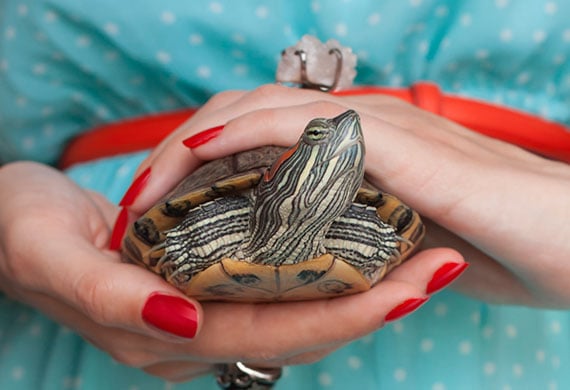
Turtles: Quiet Companions, But They Still Need Attention
By David F. Kramer
So, you're looking for a new companion pet and you've decided that a Testudine could be the right fit for you. Whether turtle, tortoise or terrapin, a pet with four legs and a shell can make for a fine companion. Turtles are fun to watch swim around in an aquarium, lazily walk their way across the terrain (e.g., your carpet), or even just chill out on a warm and comfortable rock.
As with any other pet, caring for turtles requires no small amount of research. While there are plenty of sources that can offer information on what youshoulddo for your turtle, here are some things that youshouldn't.
Image: Oleg Ermak / Thinkstock
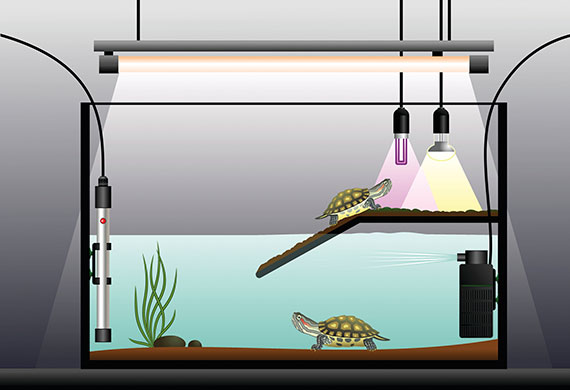
Don't Skimp on Your Turtle's Enclosure
If you're buying a turtle as a baby or hatchling, it's imperative that you consider the approximate size your turtle will be when it's fully grown. Your turtle certainly won't grow to adulthood overnight, but it's bound to occur faster than you would think.
"A baby red eared slider, for example, might be sold when it's only four inches long but can be expected to eventually reach 10 to 12 inches in length," says Dr. Jennifer Coates, a veterinarian in Fort Collins, CO. In most turtle species, females will grow quite a bit larger than males, so this is also important to consider, she adds.
A good guide is ten gallons of tank space for each inch of turtle, at a minimum. So, even a very small turtle that maxes out at a few inches is going to require a pretty sizable aquarium. Throw another turtle into the mix and you are looking at an even bigger tank. As with any pet, it's best to opt for a larger enclosure than to find yourself stuck with one that's too small.
Image: Vladimir Zadvinskiy / Thinkstock
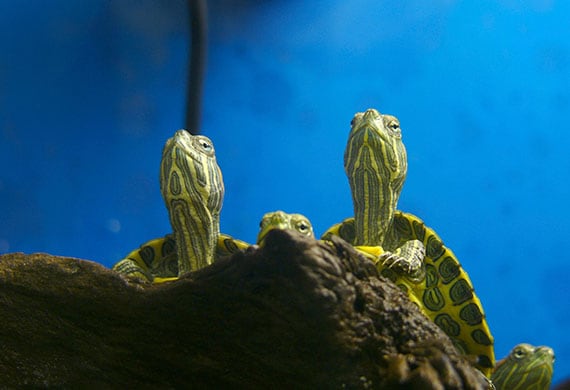
Don't Use a Glass Top on Your Turtle Tank
Turtles require both Ultraviolet A and B light to survive. Coates says that UV-B light is especially important for turtles because it "plays a major role in the production of Vitamin D3, which is needed for the absorption and metabolism of calcium." A lack of Vitamin D can cause stunted shell growth, bone disorders, and generally shorten the life of your turtle.
While sunlight will provide all the ultraviolet light a turtle needs in the wild, it's not enough to simply have your enclosure near a sunlit window. You will need to supplement ambient light with a quality UV light source placed over the tank. UVB rays cannot penetrate glass, however, so glass tank tops will negate the benefits of any sort of overhead lighting. The same is true for light shining through the sides of a glass tank. Even if you opt for a screen top for your tank, it's best if the cells of that screen are as wide as possible to allow ample UVB light to reach the turtle.
If you intend to swap out a former fish tank for your new turtle, it's best to invest in a new and more appropriate aquarium lid than the type that comes with fish tanks. Turtles aren't likely to escape a well-managed enclosure, so if you can rig things up properly, you might not need a lid at all.
Perhaps most importantly, just because a UV bulb is lit doesn't necessarily mean that it's outputting sufficient UV rays. So, it's best to replace your bulbs every 9 to 12 months, even if they're still operational. And Coates adds, "depending on your turtle's species, its diet, and your set-up, you may also need to provide a calcium and vitamin D supplement. Talk to your veterinarian about your turtle's specific needs."
Image: Nikita Tiunov / Thinkstock
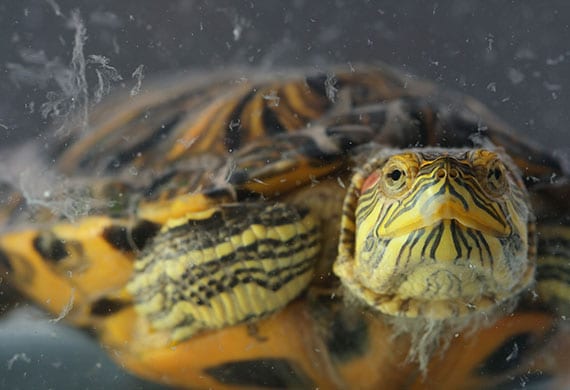
Don't Fail at Filtration
Simply put, turtles are dirty. A turtle's life is an endless circle of food going in and waste coming out—often at the same time. So, it's important that your turtle's environment be kept clean. Most of the turtles for sale as pets require both aquatic and terrestrial environments within their tank, and special attention needs to be paid to water quality.
When it comes to filtration, it is recommended that you opt for a turtle tank filter system that is strong enough to filter a tank twice the size of yours. Also, it's a good idea to invest in a vacuum, or even just a simple siphon device made for tanks, which offers a simple way to make a partial water change each time you use it—which should be at least once a week. A bubbler can help to aerate the water and improve water quality.
According to Coates, many species of turtles that come from warmer latitudes will also need their water to be heated. "For example, red eared sliders tend to do best with a water temperatures of around 80 degrees Fahrenheit."
Of course, water changes and cleaning should be done on a regular basis. The needed frequency of this will depend on the size of your tank and whether or not you use a separate tank at mealtimes, but you should change the water before it becomes dirty or foul smelling. A good general rule is to siphon about 1/2 of the water out once a week, replacing it with clean water. Coates adds that every month or two, the entire tank should be drained and thoroughly cleaned.
Image: borchee / Thinkstock
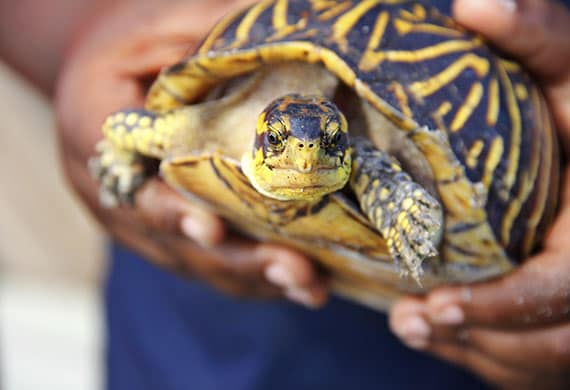
Don't Forget Reptiles Can Transmit Salmonella
Many pets, reptiles included, can carry Salmonella, a bacterial infection that is capable of being spread to humans. Symptoms of salmonellosis include diarrhea, fever, and abdominal cramps. With appropriate treatment healthy adults tend to recover from infection with Salmonella bacteria relatively quickly. The young and the elderly are more at risk for complications.
According to Dr. Adam Denish, of Rhawnhurst Animal Hospital in Pennsylvania, thinking that a turtle should "look sick" for it to be a threat is a mistake.
"Some reptiles can harbor the bacteria as a carrier but not be actively sick with an infection. Just as important, any vet can test an animal for Salmonella. However, these tests only show infection if they are shedding the bacteria in their stool at that time."
It's always best to wash your hands thoroughly after handling your turtle or cleaning its enclosure. Small children handling turtles should be supervised to ensure they don't place them near their eyes or mouths and that they wash their hands afterwards. But all of this shouldn't talk you out of getting a turtle, after all, any pet has the potential to transmit disease. These simple precautions are simply your best protection against getting sick.
Image: Creativestock / Thinkstock
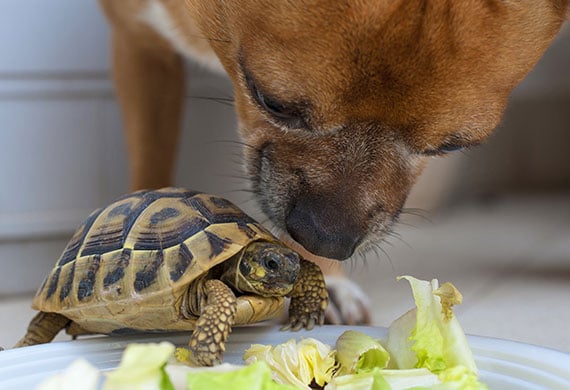
Don't Mix Turtles and Other Pets Without Close Supervision
It goes without saying that pets of different types might need to be kept apart or watched closely when they're in the same proximity. While pet ownership has turned many unlikely combinations of animals into lifelong friends (and cute internet memes), it only takes a moment for instinct to take over and turn a friend into food. A dog or cat may view your new turtle with curiosity at first, but a simple exploratory scratch or bite can easily cause serious, and potentially lethal, harm. And there is the same threat of Salmonella infection from turtles to other pets as there is to humans (see the previous slide).
While a cat is probably more likely to have the skill to get up and into your turtle's enclosure, never underestimate the brute force of an eager and leaping dog, no matter the size. There is also the risk of one or both animals being injured, or possibly killed, by a falling aquarium.
Keep any enclosure back from the edges of shelves, tables, or bureaus, and secure cords going to and from lights, heaters, and filters to avoid both tripping and curious mouths.
Image: talitha_it / Thinkstock
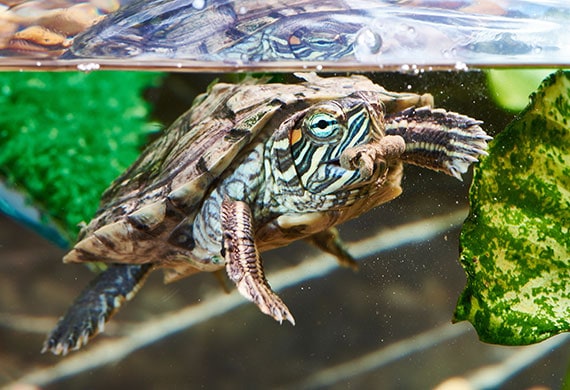
Don't Overfeed Your Turtle
Like many other animals, turtles are opportunistic feeders and will often continue to eat as long as food is available. Turtles will also "beg" for food when you pass by their enclosure or venture near that coveted food shelf. While it's hard to resist, overfeeding a turtle can lead to serious consequences. Coates warns that obesity and hepatic lipidosis (fatty liver disease) are two conditions that are related to overfeeding pet turtles.
While growing, juvenile turtles need to be fed fairly often, adult turtles can be fed a few times per week, depending on the species. Give your turtle a healthy combination of store bought turtle pellets, fresh leafy greens, and finely chopped fruits and vegetables. Because most turtles are omnivorous, many will also enjoy small fish, shrimp, and insects as a special treat. Any of these foods can be dusted with calcium powder to provide an extra boost of this vital nutrient.
On the flip side, many species observe a hibernation period and may refuse food for long periods of time. If your turtle does stop eating and you are concerned that it may be ill, be sure to schedule a checkup with your veterinarian.
It's always best to remove any uneaten food from a turtle's enclosure to avoid a mess from cast-off and decaying matter, which can make the tank water get very nasty. Some owners feed their turtles in a separate area to avoid this from happening.
Image: sergeyryzhov / Thinkstock
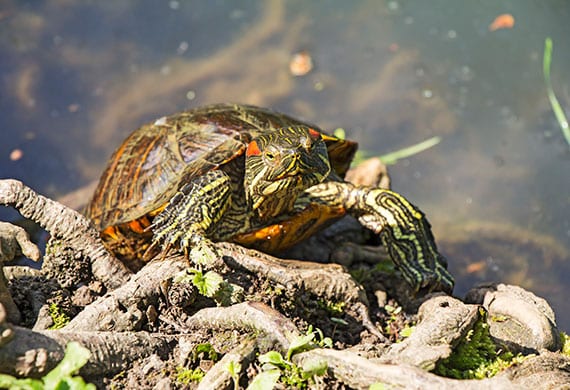
Don't Release Your Turtle into the Wild
Any animal lover would recoil at the prospect of leaving a cat or dog to its own devices in the wild. However, someone who owns a turtle and can no longer care for it might think that there's a perfect spot in a nearby pond or forest that would be just the place for a turtle. After all, some say, there are probably other turtles there, and an abundance of food, water, and sunlight. But no, this is never a good idea.
While the natural instincts of turtles would probably kick in, a turtle that has been captive most or all of its life will not have the keen hunting skills of a wild one. Also, any manageable disease that a turtle might pick up in captivity can run rampant and unchecked if it's released into the wild. So, between the natural competition for food, the uncertainty of the weather, and disease, your pet will have little chance of survival, not to mention the damage it might cause to native animals.
If you need to rehome a turtle, there are any number of internet groups and organizations that might be able to help find a suitable new family for it (see related links below). While your local pet store is unlikely to accept your turtle, they might be able to steer you in the right direction or allow you to post on their community boards.
In all circumstances, the decision to own a pet, turtle or otherwise, is not something that should be taken lightly. Do your research so that you can be sure that you are prepared to care for any animal companion you choose to call your own.
Image: vansmuk / Thinkstock
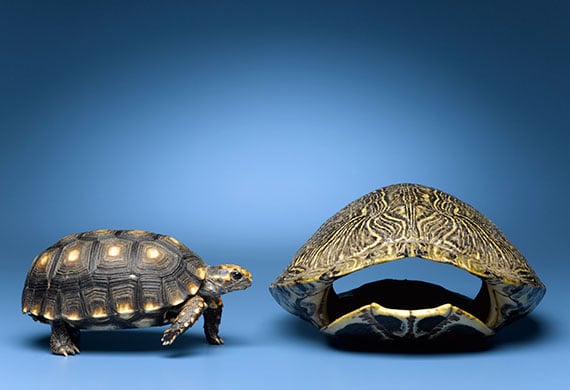
Additional Slideshows
What Is the Extra Color Turtles Can See
Source: https://www.petmd.com/reptile/slideshows/care/seven-things-not-do-your-turtle